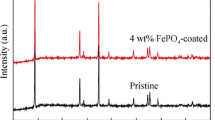Abstract
Li1 − x K x FePO4/C (x = 0, 0.03, 0.05, and 0.07) composites were synthesized at 700 °C in an argon atmosphere by carbon thermal reduction method. Based on X-ray diffraction, scanning electron microscopy, and transmission electron microscopy analysis, the composite was ultrafine sphere-like particles with 100–300 nm size, and the lattice structure of LiFePO4 was not destroyed by K doping, while the lattice volume was enlarged. The electrochemical properties were investigated by four-point probe conductivity measurements, galvanostatic charge and discharge tests, cyclic voltammetry and electrochemical impedance spectroscopy. The results indicated that the capacity performance at high rate and cyclic stability were improved by doping an appropriate amount of K, which might be ascribed to the fact that the doped K ion expands Li ion diffusion pathway. Among the doped materials, the Li0.97K0.03FePO4/C samples exhibited the best electrochemical activity, with the initial discharge capacity of 153.7 mAh g−1 at 0.1 C and the capacity retention rate of about 92% after 50 cycles at above 1 C, 11% higher than undoped sample. Remarkably, it still showed good cycle retention at a high current rate of 10 C.









Similar content being viewed by others
References
Padhi AK, Nanjundaswamy KS, Goodenough JB (1997) J Electrochem Soc 144:1188–1194
Yonemura M, Yamada A, Takei Y, Sonoyama N, Kanno R (2004) J Electrochem Soc 151:A1352–A1356
Striebel K, Shim J, Srinivasan V, Newman J (2005) J Electrochem Soc 152:A664–A670
Anderson AS, Thomas JO (2001) J Power Sources 97–98:498–502
Chung SY, Chiang YM (2003) Eletrochem Solid State Lett 6:A278–A281
Delacourt C, Poizot P, Tarascon JM, Masquelier C (2005) Nat Mater 4:254–260
Sides CR, Croce F, Young VY, Martin CR, Scrosati B (2005) Electrochem Solid State Lett 8:A484–A487
Park KS, Son JT, Chung HT, Kim SJ, Lee CH, Kang KT, Kim HG (2004) Solid State Commun 129:311–314
Delacourt C, Poizot P, Levasseur S, Masquelier C (2006) Electrochem Solid State Lett 9:A352–A355
Choi D, Kumta PN (2007) J Power Sources 163:1064–1069
Chung SY, Blocking JT, Chiang YM (2002) Nat Mater 2:123–128
Hong J, Wang CS, Kasavajjula U (2006) J Power Sources 162:1289–1296
Wang DY, Li H, Shi SQ, Huang XJ, Chen LQ (2005) Electrochim Acta 50:2955–2958
Yin XG, Huang KL, Liu SQ, Wang HY, Wang H (2010) J Power Sources 195:4308–4312
Liu H, Cao Q, Fu LJ, Li C, Wu YP, Wu HQ (2006) Electrochem Commun 8:1553–1557
Ouyang CY, Wang DY, Shi SQ, Wang ZX, Li H, Huang XJ, Chen LQ (2006) Chin Phys Lett 23:61–64
Sun LQ, Cui RH, Jalbout AF, Li MJ, Pan XM, Wang RS, Xie HM (2009) J Power Sources 189:522–526
Yao J, Konstantinov K, Wang GX, Liu HK (2007) J Solid State Electrochem 11:177–185
Kawakita J, Makino K, Katayama Y, Miura T, Kishi T (1998) J Power Sources 75:244–250
Wu YP, Rahm E, Holze R (2002) Electrochim Acta 47:3491–3507
Chen H, Yu WZ, Han SC, Xu ZY (2007) J Trans Nonferrous Met Soc China 17:951–957
Wang BF, Qiu YL, Ni SY (2007) Solid State Ionics 178:843–847
Bard AJ, Faulkner LRM (2001) Electrochemical methods, 2nd edn. Wiley, New York, p 231
Wang YR, Yang YF, Hu X, Yang YB, Shao HX (2009) J Alloys Compd 481:590–594
Acknowledgement
This work was financially supported by Central South University Postdoctoral Foundation (No. 09hn1693).
Author information
Authors and Affiliations
Corresponding author
Rights and permissions
About this article
Cite this article
Fang, X., Li, J., Huang, K. et al. Synthesis and electrochemical properties of K-doped LiFePO4/C composite as cathode material for lithium-ion batteries. J Solid State Electrochem 16, 767–773 (2012). https://doi.org/10.1007/s10008-011-1426-4
Received:
Revised:
Accepted:
Published:
Issue Date:
DOI: https://doi.org/10.1007/s10008-011-1426-4




